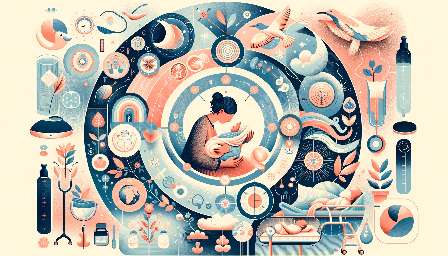Pregnancy is an intricate and miraculous physiological process that involves a complex interplay of hormones to support the growth and development of the fetus. Throughout gestation, childbirth, and the postpartum period, various hormones play crucial roles in regulating the physiological changes in the mother's body. Understanding the influence of hormones in pregnancy is essential to comprehend the physiology of pregnancy and childbirth.
Hormonal Regulation in Pregnancy
The hormonal orchestration in pregnancy begins with the complex interplay of several key hormones, primarily produced by the mother and the developing placenta. These hormones are instrumental in maintaining the pregnancy, establishing the maternal-fetal interface, and preparing the mother's body for childbirth. Some of the key hormones involved in pregnancy include:
- Progesterone: Progesterone is essential for maintaining the uterine lining and preventing contractions that could lead to early labor. It is primarily produced by the corpus luteum in the early stages of pregnancy and later by the placenta.
- Estrogen: Estrogen, particularly estradiol, plays a vital role in stimulating the growth of the uterus and promoting blood flow to the uterine lining. It also contributes to the development of fetal organs and differentiation of mammary tissue in preparation for lactation.
- Human Chorionic Gonadotropin (hCG): Produced by the placenta, hCG helps to support the early stages of pregnancy by stimulating the corpus luteum to continue producing progesterone until the placenta can take over this function.
- Oxytocin: Often referred to as the 'love hormone,' oxytocin plays a significant role in uterine contractions during labor and is involved in the bonding between the mother and baby.
- Relaxin: This hormone helps to relax the ligaments in the pelvis to facilitate the stretching and expansion needed for childbirth, and it also plays a role in softening the cervix.
- Prolactin: Prolactin levels rise during pregnancy, preparing the mammary glands for milk production.
Physiology of Pregnancy
The physiological changes during pregnancy are intricately linked to the actions of hormones. As the embryo implants in the uterus, hormonal signals trigger a cascade of events that support the growth and development of the fetus.
First Trimester:
During the first trimester, progesterone and estrogen play pivotal roles in maintaining the uterine lining and promoting the growth of the placenta. These hormones also contribute to the suppression of the mother's immune system to prevent rejection of the developing embryo, and they support the early development of the fetus.
Second Trimester:
As the pregnancy progresses, the placenta becomes the primary source of hormone production. Estrogen levels continue to rise, promoting further growth of the uterus and the fetus, while the production of relaxin helps to prepare the mother's body for the expansion required during labor. Additionally, hCG levels reach their peak and then decline, marking a shift in hormonal balance as the placenta becomes more established.
Third Trimester:
In the final trimester, the hormones collaborate to prepare the mother's body for labor and childbirth. Higher levels of oxytocin and estrogen contribute to uterine contractions and cervical ripening, essential processes for the onset of labor. Additionally, prolactin levels increase in preparation for lactation, while maternal levels of progesterone decrease, allowing the uterine muscles to respond to contractions more effectively.
Childbirth and Postpartum Phase
Hormonal dynamics continue to play a critical role during childbirth and in the subsequent postpartum period. The body undergoes significant hormonal shifts and adjustments as labor progresses and the mother transitions into the postpartum phase.
Labor:
As labor commences, the release of oxytocin intensifies, producing rhythmic contractions of the uterus, which are essential for delivering the baby. Oxytocin also helps in initiating the milk ejection reflex during breastfeeding, facilitating maternal-infant bonding. Furthermore, adrenaline levels rise, contributing to the energy and drive needed during labor.
Postpartum:
After childbirth, hormonal changes continue as the body adjusts to the cessation of pregnancy. Oxytocin remains crucial in promoting uterine involution, assisting in the contraction of the uterus to reduce bleeding. Prolactin levels remain elevated to support breastfeeding, while estrogen and progesterone levels gradually return to pre-pregnancy levels, signaling the completion of the reproductive cycle and the initiation of the postpartum recovery phase.
In conclusion, the role of hormones in pregnancy is a fascinating display of physiological intricacies that support the growth and development of the fetus and facilitate the process of childbirth. Understanding the hormonal dynamics in pregnancy provides crucial insights into the physiology of pregnancy and childbirth, highlighting the remarkable coordination of biological processes that occur to bring new life into the world.


